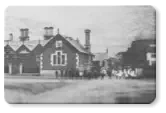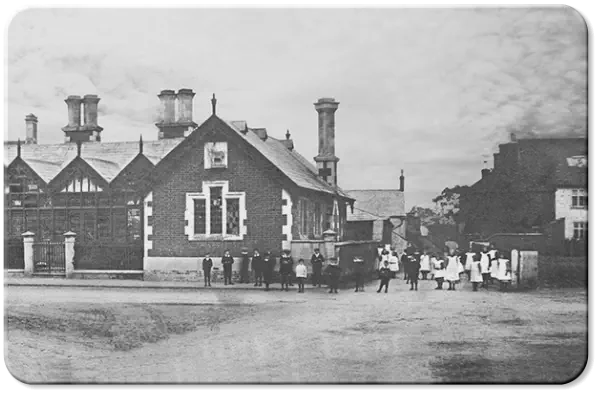There is no record of a school in Langham before 1640 when Mr Boyd was teaching
children in the church.
In 1692, Langham was one of several Rutland parishes to benefit from Forster’s
Charity which gave £10 a year to pay a schoolmaster.
In 1802 the north transept of the church, which had been used as a school room, was
taken down but the churchwardens’ accounts show that schooling continued to be
paid for after that date. It is possible that the scholars moved to the cottage at the west end of the church
where, what was known as a Glebe School was apparently held at one time.
In 1820 Forsters’ Charity was paying a schoolmaster in Langham to teach 34 free scholars. This may have been
Mr Hack or possibly George Fowler, who in 1828, petitioned Lord Gainsborough for a “close” on which to graze
his livestock and refers to having been a schoolmaster in Langham for 18 years and to have the honour of being
his Lordship’s tenant already by virtue of renting a school room.
In 1841 the Earl of Gainsborough built a British School which he supported. The pupils paid one penny a week.
(A British School was non-denominational under the auspices of the British and Foreign Society.) White’s
Directory of 1846 calls the school “a neat building in the Swiss style... usually attended by forty of each sex”.
In 1876 the Vicar and Churchwardens were granted trusteeship of the school for the education of children and
adults or children only of the labouring, manufacturing and poorer classes and such other purposes the
management committee saw fit. The committee was to consist of the vicar, two churchwardens and four others
subscribed not less than £10 per annum. The first committee members were Lord Gainsborough, Lord
Lonsdale, George Finch Esq. and William Sherrard Esq.
The curriculum was reading, writing, arithmetic, geography, scripture, history and, for the girls, needlework.
The Bible was to be read daily but no child was required to learn catechism or attend a Sunday School without
parental consent.
(In 1970, under the terms of the grant, made in accordance with the Elementary Schools Act of 1870, the
property reverted to the Gainsborough Estate when it ceased to be a school.)
A National School (supported by the National Society for promoting religious education in accordance with the
principles of the Church of England) was apparently set up in 1843 by the vicar. The schoolmaster received £36
a year from Forster’s Charity.
The building now known as Old Hall Cottage was formerly a row of cottages known as School Row and was
described in the 1925 Gainsborough Sale as “Four stone built cottages with yard and outbuildings thereto
belonging, situate in School Yard”. Perhaps this was the home of the National School.
At some stage the schools must have united. In White’s Directory 1863 the two schools are mentioned but in
Harrod’s Directory 1870 there is reference only to the British school.
The School Log Book begins with the entry for 17 January 1876: Langham Government Mixed School was
reopened... Entered seventy-four children, their attainment is on a low scale, which perhaps may be attributed
to the closing of the School for the last few months on account of repairs etc. going on.
This then was the beginning of the Langham Church of England (Controlled) School. The building of the present
school premises, on the site of the former playground, began in 1966 and the school opened in 1967. Further
extensions were built and opened in 1972.


Langham Village History Group ~ © 1996 - 2025
Schooling in Langham



There is no
record of a school in Langham
before 1640 when Mr Boyd was teaching children in the church.
In 1692, Langham was one of several Rutland parishes to benefit from Forster’s
Charity which gave £10 a year to pay a schoolmaster.
In 1802 the north transept of the church, which had been used as a school room, was
taken down but the churchwardens’ accounts show that schooling continued to be
paid for after that date. It is possible that the scholars moved to the cottage at the west end of the church
where, what was known as a Glebe School was apparently held at one time.
In 1820 Forsters’ Charity was paying a schoolmaster in Langham to teach 34 free scholars. This may have been
Mr Hack or possibly George Fowler, who in 1828, petitioned Lord Gainsborough for a “close” on which to graze
his livestock and refers to having been a schoolmaster in Langham for 18 years and to have the honour of being
his Lordship’s tenant already by virtue of renting a school room.
In 1841 the Earl of Gainsborough built a British School which he supported. The pupils paid one penny a week.
(A British School was non-denominational under the auspices of the British and Foreign Society.) White’s
Directory of 1846 calls the school “a neat building in the Swiss style... usually attended by forty of each sex”.
In 1876 the Vicar and Churchwardens were granted trusteeship of the school for the education of children and
adults or children only of the labouring, manufacturing and poorer classes and such other purposes the
management committee saw fit. The committee was to consist of the vicar, two churchwardens and four others
subscribed not less than £10 per annum. The first committee members were Lord Gainsborough, Lord
Lonsdale, George Finch Esq. and William Sherrard Esq.
The curriculum was reading, writing, arithmetic, geography, scripture, history and, for the girls, needlework.
The Bible was to be read daily but no child was required to learn catechism or attend a Sunday School without
parental consent.
(In 1970, under the terms of the grant, made in accordance with the Elementary Schools Act of 1870, the
property reverted to the Gainsborough Estate when it ceased to be a school.)
A National School (supported by the National Society for promoting religious education in accordance with the
principles of the Church of England) was apparently set up in 1843 by the vicar. The schoolmaster received £36
a year from Forster’s Charity.
The building now known as Old Hall Cottage was formerly a row of cottages known as School Row and was
described in the 1925 Gainsborough Sale as “Four stone built cottages with yard and outbuildings thereto
belonging, situate in School Yard”. Perhaps this was the home of the National School.
At some stage the schools must have united. In White’s Directory 1863 the two schools are mentioned but in
Harrod’s Directory 1870 there is reference only to the British school.
The School Log Book begins with the entry for 17 January 1876: Langham Government Mixed School was
reopened... Entered seventy-four children, their attainment is on a low scale, which perhaps may be attributed
to the closing of the School for the last few months on account of repairs etc. going on.
This then was the beginning of the Langham Church of England (Controlled) School. The building of the present
school premises, on the site of the former playground, began in 1966 and the school opened in 1967. Further
extensions were built and opened in 1972.


Langham Village History Group ~ © 1996 - 2025













![Close [x]](index_htm_files/close.png)










































